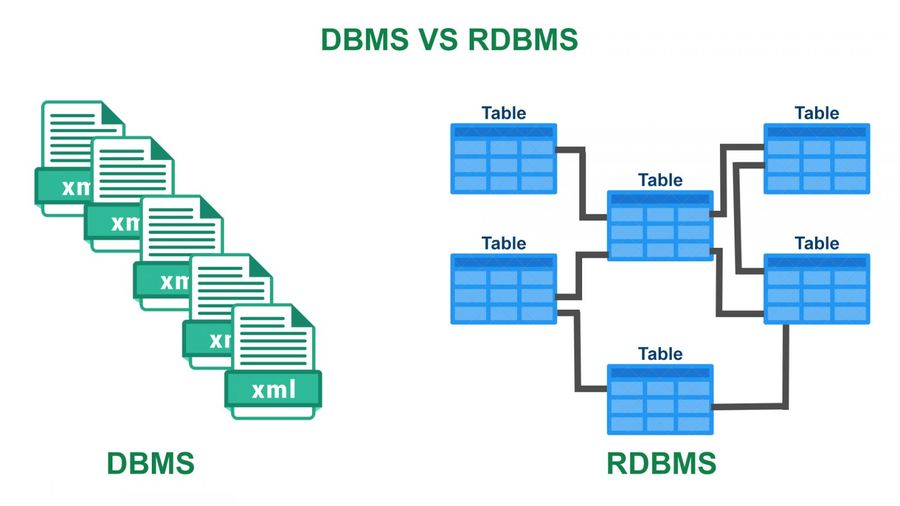Data has now become a key component of any organization. Companies use their business data to analyze their economic health and create business strategies. Data present in customer reports, market surveys, client data and stakeholder information needs to be managed properly.
This is where a Database Management System comes in. It is used for collecting, storing, processing and retrieving data. An RDMS is an advanced version of it.
In this post, we will compare DBMS and RDBMS to understand their difference.
DBMS vs RDBMS
DBMS (Database Management System) and RDBMS (Relational Database Management System) are both used for the storing information in the form of physical databases. DBMS is a combination of interrelated data and a group of programs for accessing that data.
On the other hand, RDBMS is the type of DBMS that has been designed to take care of the inefficiencies of DBMS.

The table below will points out the key differences between DBMS and RDBMS.
| DBMS | RDBMS |
|---|---|
| Data is stored in a file. | Data is stored in the form of tables. |
| DBMS supports a single user. | RDBMS supports multiple users. |
| Data is stored using navigational or hierarchical formats. | RDBMS uses a tabular format to store data. Headers represent column names, and the values are stored in rows. |
| A DBMS may not be able to store data by following the ACID (Atomicity, Consistency, Isolation, Durability) model. This can cause inconsistencies in the data. | Relational databases always follow the ACID model while storing data. Hence, inconsistencies are reduced. |
| DBSMS is a software program used for managing databases on systems and networks. | RDBMSs are mainly used for maintaining the relationships among tables. |
| DBMS does not support Normalization. | RDBMS supports Normalization. |
| Low software/hardware requirements. | Higher software/hardware requirements. |
| Does not support distributed databases. | RBMS supports distributed databases. |
| A DBMS follows about 7 Codd Rules. | An RDBMS follows around to 8 to 10 Codd Rules. |
| Does not support client-server architecture. | RDBMS supports client-server architecture. |
| You may find data redundancies in a DBMS model. | The keys and indexes in an RDBMS do not allow any data redundancy. |
| DBMS systems are designed to handle small/ moderate sets of data. | RDMS systems are designed to handle large sets of data. |
| Data fetching gets slower while working with large and complex data sets. | Rapid data fetching is possible even if the data sets are large and complicated |
| Low levels of data security. | There exists multiple levels of data security in an RDBMS. |
| Data elements need to be accessed individually. | Data elements can be easily accessed using SQL queries. You can also access multiple data elements with ease. |
| There is no relationship between different data elements in a DBMS. | Data is stored in the form of tables which are related to each other using foreign keys. |
| DBMS does not support integrity constants. These constants cannot be applied at the file levels. | RDBMS supports integrity constraints. The support is provided at the schema levels. Values beyond a specific range cannot be stored in a particular RDMS column. |
| It is difficult to modify any data and store it, as duplicate copies may be present in other parts of the DBMS. | Due to low data duplication in an RDBMS, you can easily modify, store and implement data. |
| DBMS examples include Windows Registry, file systems and XMLs. | RDBMS examples include Oracle, MySQL and SQL Server. |
What is DBMS?
Database Management System is a software designed for storing and managing data. It was introduced during the 1960s as a system for storing all kinds of data. DBMS is also helpful in the manipulation of stored data. It consists of different groups of interrelated data that has been arranged in proper order.
The data in a DBMS can be manipulated using commands. These act an interface between the database and the users. Processes like insertion, deletion and modification of data can be performed in a DBMS. It supports numerous database functions such as defining, controlling creating, revising, etc. of the database.
A DBMS helps business applications and managers extract the desired (stored) data very conveniently. It also helps them in performance tuning and backing up data.
Types of DBMS
The major types of DBMSs are –
- Network databases:Network databases appear like cobwebs or interconnected networks of data and records.
- Relational databases: The data in a relational database is stored in the form of access control tables. These tables have a key field that identifies each row of stored data.
- Object-oriented databases:These offer you the power of Object-oriented programming and a relational database. Here, data is stored as objects, just like OOP languages such as C++.
- Hierarchical databases: This DBMS is very fast and simple. The data is arranged in the form of a tree structure in hierarchical databases.
What is RDBMS?
RDBMS stands for Relational Database Management System. It is an advanced form of DBMS. RDBMS was first introduced during the 1970s. It allows businesses to access data more conveniently and efficiently than a standard DBMS.
An RDBMS is a software system used for storing data in the form of tables. The rows and columns of an RDBMS are referred to as rows and columns. They are helpful for the management and storage of data. They are used widely across the world because of their high efficiency and utility.
Conclusion
A Database Management System (DBMS) is a software used for managing and storing data. At the same time, a Relational Database Management System (RDBMS) is an enhanced version of DBMS.
The differences between an RDBMS and DBMS that have been discussed earlier. In case we have missed out any point, drop a comment below and we will include it.